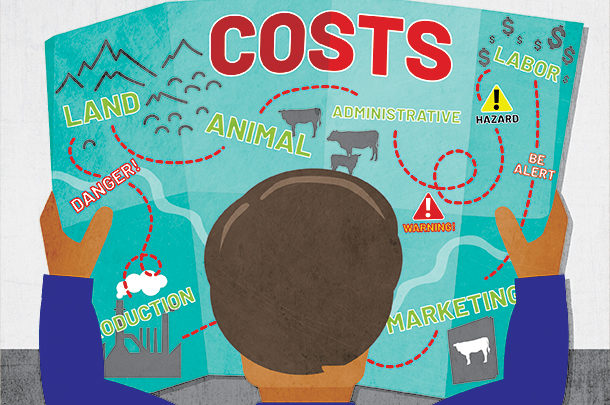Beef production costs can be a wildly moving target with variables often seemingly too numerous to count. From the producer’s standpoint, capturing all the expenses related to production, transportation, feed, fertilizer, animal health, maintenance, taxes, insurance, etc. can be a challenge, as well as very intimidating.
Varying as these expenses do – year to year, region to region – grasping a total production cost may seem overwhelming. But let’s wrap our brains around this issue. Because of the exceptional variation of production costs, it is impossible to quote specifics. This can only be done on an operational basis. Quantification of production expenses, expected sales revenues and calculating profits may make cattle farming one of the most difficult and complex businesses in existence.
Capturing all the costs associated with producing a beef animal from conception to serving on the dinner table is very challenging. Here we will primarily focus on the cow-calf operation. Profitability from the point of initial production to final sale of the animal in today’s market is elusive. This is then combined with the adversarial relationship between the producer and the final cattle buyer, the packer. This can be carried steps further as we look at how meat products are bought, distributed and retailed after harvest and processing. Few cattle producers have a grasp of this world, aside from seeing what a cut of meat costs in the meat case at the grocery store or on the menu at a restaurant.
Land resource cost
The biggest production expense is the land resource. For the typical cow-calf producer, there is the expense of acquiring and maintaining land. This will vary depending on location and market values. It will also depend on access to water, rainfall and soil quality, which will directly impact the amount of land required to “carry” a cow. If land is leased or rented, this cost identification is simpler. For example, the producer knows he needs 5 acres to carry one cow for a year. The rent cost per acre is $15 per year. Thus, the land resource cost is $75 per year. Additional land costs might be liability insurance but should be factored in somehow.
If land is owned outright, then the primary costs would include taxes and liability insurance. If the property is mortgaged, there would be a land payment, which includes interest, taxes and insurance. Again, these expenses are highly variable depending on region and circumstance.
Animal cost
What is your origination expense in having one cow that can produce a calf? Again, there are variations here. Was that cow produced on the farm or was it purchased? If so, there are all the production costs leading up to that animal being in place and being bred. Fortunately, this cost can be divided by the number of anticipated productive years or the number of calves it will produce. Depending on all the circumstances, this may be one to 10 or 12. So if it costs $800 to produce a bred heifer and the salvage cost for that animal when retired is $400 and the average number of calves it can produce is eight, the annual animal cost is then $50. This might also be considered the depreciation of that animal.
A second related cost is the bull or breeding expense. Most farms buy the necessary bulls needed for breeding cows. Again, there is potentially a wide range in the actual cost of bulls. However, once in place, this cost for the animal himself is spread across the calf crop. For operations that use a single bull for a single breeding season for several years, the cost is divided by the number of productive years or by the number of calves sired.
For instance, if a bull is purchased for $3,000 and is sold after the third breeding season for $1,000, then his overall cost is $2,000. Divided by three productive years, used for a single breeding season on 30 cows, and the farm has a 90% breeding-to- weaning rate, he produces 81 calves. So the $2,000 cost divided by 81 calves is $24.69 per calf. This can and should be broken down even further to the cost per pound of calf, since the bull can have a significant effect on the market weight of that calf.
Equipment costs
Equipment includes trucks, tractors, trailers, shredders, hay balers, plows, grain drills, squeeze chutes, tools, etc. There is the initial cost to acquire each piece. Some equipment (i.e., trucks or tractors) also have yearly maintenance costs. These generally go up with time and use. The annual cost and what this contributes to annual production costs and per animal or per pound of beef produced needs to be considered.
Calculating these costs per year per animal per pound can be difficult since we don’t know how long a given piece of equipment may be kept and used. In some cases, you will find operations that trade their tractors every four to five years. Other farms may keep a tractor for 20 or more years. It is important that the producer make a list of as much equipment as possible, calculate a projected value and how long it is intended for that equipment be kept. Then for each piece, project an end or salvage value.
Production costs
Production costs, despite their variability, may actually be one of the simpler costs to capture. Typical production costs may include:
1. Forage production costs – both for pasture and stored forages (hay, silage)
- Fuel
- Equipment maintenance
- Seed
- Fertilizer
- Weed control (mechanical and chemical)
- Insect control
- Harvest
- Storage
2. Feeding and supplementation
- Mineral and vitamins
- Protein and energy
- Transportation and delivery
- Storage
3. Pest management
- External parasites:
- Fly control (tags, chemical sprays, feed-through products)
- Other external parasites (lice, grubs, ticks)
- Internal parasites
4. Animal health costs
- Medications (vaccines, antibiotics, etc.)
- Supplements, injectable vitamins, minerals, other
- Processes (dehorning, castration)
- Identification (branding, eartagging)
- Vet-related:
- Palpation
- Treatments for sickness
- Calving assistance
- Hoof and foot issues
- Disposal of animal mortalities
5. Breeding and reproduction
6. Maintenance and repairs
7. Fuel
8. Utilities (electricity, water, gas, phone, internet)
9. Other animal expense (horses if used for operation, dogs)
Labor costs
Labor costs may be the most inaccurately calculated value simply because so many producers will not account for their own time or that of their families. This is particularly true for those producers who operate their farm or ranch on a part-time basis. Often the labor contributed by the owner and family is not added in at all.
Labor is often considered as what the operation pays for the labor on a full-time or part-time basis. This can include hired labor and custom work labor (planting, harvesting, cattle processing, etc.).
Marketing costs
What does it cost to sell the animals produced on the farm or ranch? This will depend on how they are marketed. Costs may include:
-
Transportation
-
Sale barn costs (commissions, facility charges)
-
Beef checkoff
-
Shrink (often not considered, especially in cattle sold through auction facilities)
- Advertising
Administrative costs
Administrative costs are also wide ranging. This can also be considered management costs and may include accountant or book-keepers’ fees, memberships, etc.
One important cost, if any expenses are financed, is interest cost. Since few operations are operated on a 100% cash basis, this is an important item. It should include all interest paid on loans for land, animals, equipment and machinery, operating expenses, etc. It should include interest on any credit card purchases for the farm.
Another expense that can be listed here is insurance. This might include property insurance for buildings or equipment, crop insurance for grown crops, livestock and liability (property and vehicles).
Other costs include office expenses such as supplies, computers, subscriptions, etc. Again, this is highly variable depending on the operation.
Conclusions
Identifying and tracking expenses is critical for any business, especially for a beef cattle production operation. I’ve had many producers tell me that they don’t really want to know a bottom-line cost. But if you are in the business and even remotely serious about what you are doing, it is critical to know these numbers. In animal performance, we say, “You can’t manage something that you don’t measure.” This is true here, and the more of these expenses associated with the cattle operation that can be tracked and analyzed, the better opportunity there is to improve profitability.
A final word – there are a variety of good online resources available to assist with tracking and analyzing your costs. Many land-grant universities have these tools on their websites and are easily accessible. ![]()
ILLUSTRATION: Illustration by Kristen Phillips.
Dr. Steve Blezinger is a nutritional and management consultant with an office in Sulphur Springs, Texas. He can be reached at (903) 352-3475.

-
Stephen B. Blezinger
- Reveille Livestock Concepts
- Sulphur Springs, Texas
- Email Stephen B. Blezinger









